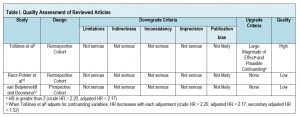The Relationship between Cesarean Delivery and Increased Risk of Developing Asthma in Childhood
Abstract
Background: Asthma prevalence nationwide is increasing. In 2011, an estimated 39.5 million individuals, or 12.9% of the population, had a diagnosis of asthma, and 14% of those were children. Rate of cesarean delivery (CD) has concurrently increased over the past few decades and comprised 32.2% of all deliveries in 2014. Recent research has begun to explore for possible association between CD and later asthma development. Studies may even suggest differences in the gastrointestinal microbiome of neonates after CD and that of neonates after vaginal delivery (VD); this microbiome has been shown to affect development of a properly functioning immune system. This review aims to investigate whether there is increased risk of asthma development in childhood after CD.
Methods: An extensive literature search of Web of Science, CINAHL, and MEDLINE via PubMed and Ovid databases was performed using the following search terms: caesarean or cesarean, asthma, and intestinal flora or gastrointestinal microbiome. Articles were screened for relevance and eligibility criteria. An assessment of quality was performed for the resulting included studies using the GRADE system.
Results: The literature search yielded a total of 3 qualifying studies: 2 were retrospective cohort studies while the other was a prospective cohort study. The overall quality of those included was low; however, one study was upgraded to high quality with reasons. Results were consistent between the three studies when comparing asthma development after CD to that after VD. These studies support that children have an increased risk of asthma if delivered via CD, particularly female and first-born children.
Conclusion: Based on recent studies, there appears to be an increased risk of asthma development in children delivered via CD compared to those spontaneously vaginally delivered (SVD). This trend is significant only in female and first-born children. Further research is needed in order to advance current knowledge and understanding of which bacteria colonize the gut in asthmatic versus non-asthmatic children and how this difference in introduction of organisms results in abnormal immune system development. Future conclusive evidence may foster advancements in asthma therapy and prevention.
Keywords: Cesarean, delivery, asthma, intestinal flora, gastrointestinal microbiome
(Click on image to enlarge.)
REVIEWED STUDIES:
Tollånes, M. C., et al. Cesarean section and risk of severe childhood asthma: a population-based cohort study. The Journal of Pediatrics, 2008;153:112-116.
Renz-Polster, H., et al. Caesarean section delivery and the risk of allergic disorders in childhood. Clinical and Experimental Allergy, 2005;35:1466-1472.
van Beijsterveldt, T. and Boomsma, D. Athma and mode of delivery: A study in 5-year-old Dutch twins. Twin Research and Human Genetics, 2008;11(2):156-160.
AUTHOR: Nicole Ankenbrandt graduated from Pacific University, School of PA Studies with an MS degree in August 2017.



No Comments Yet